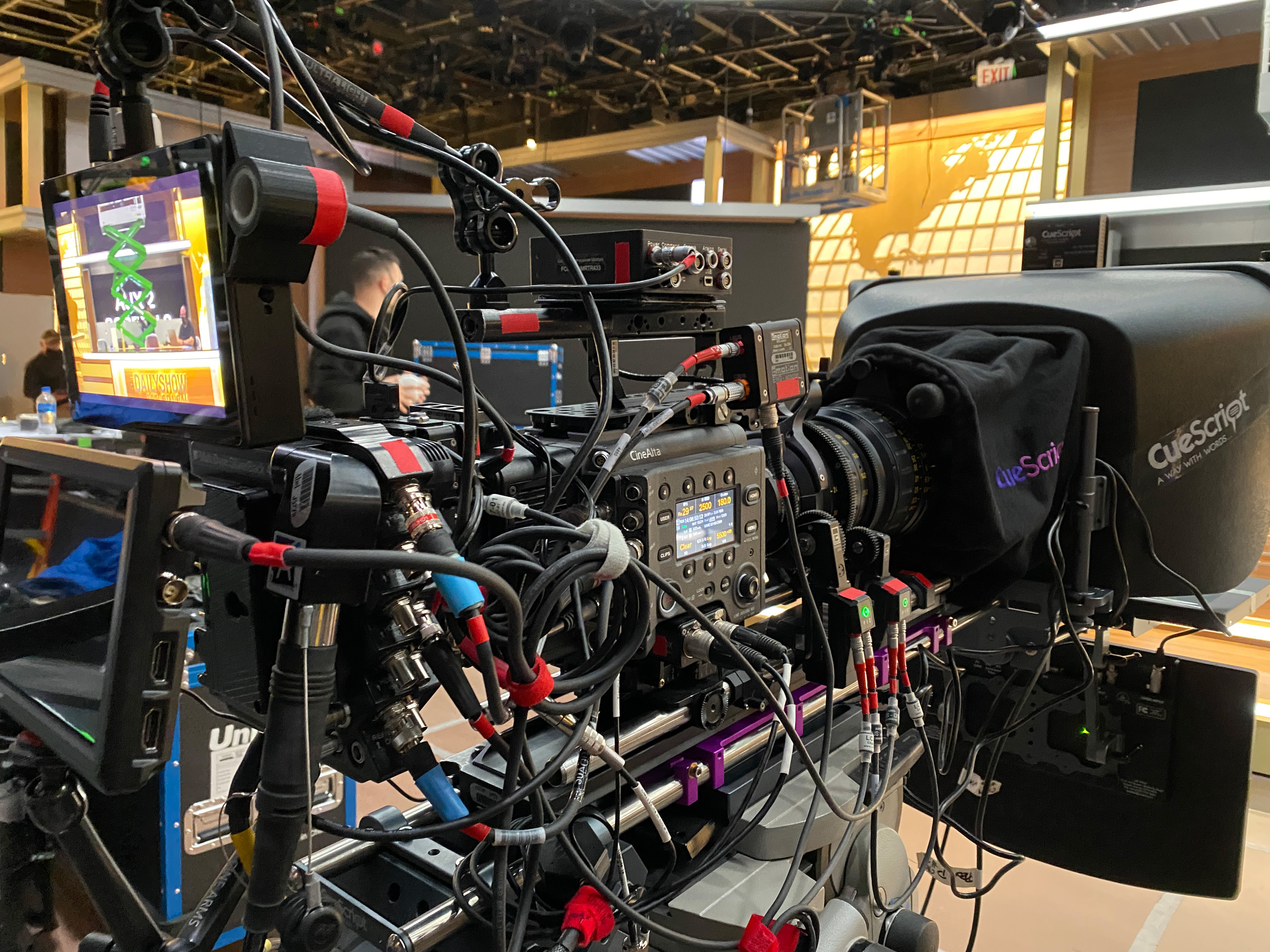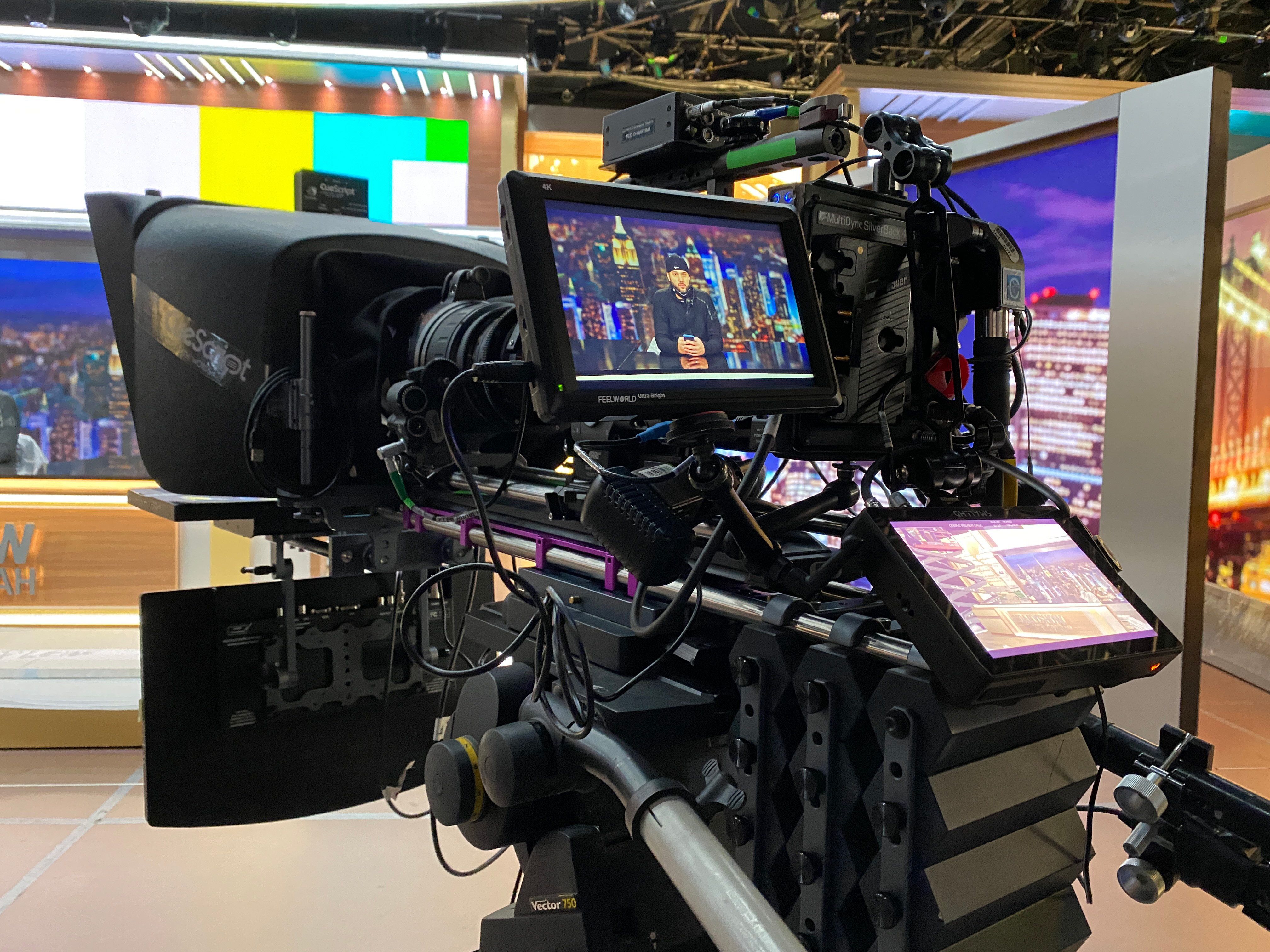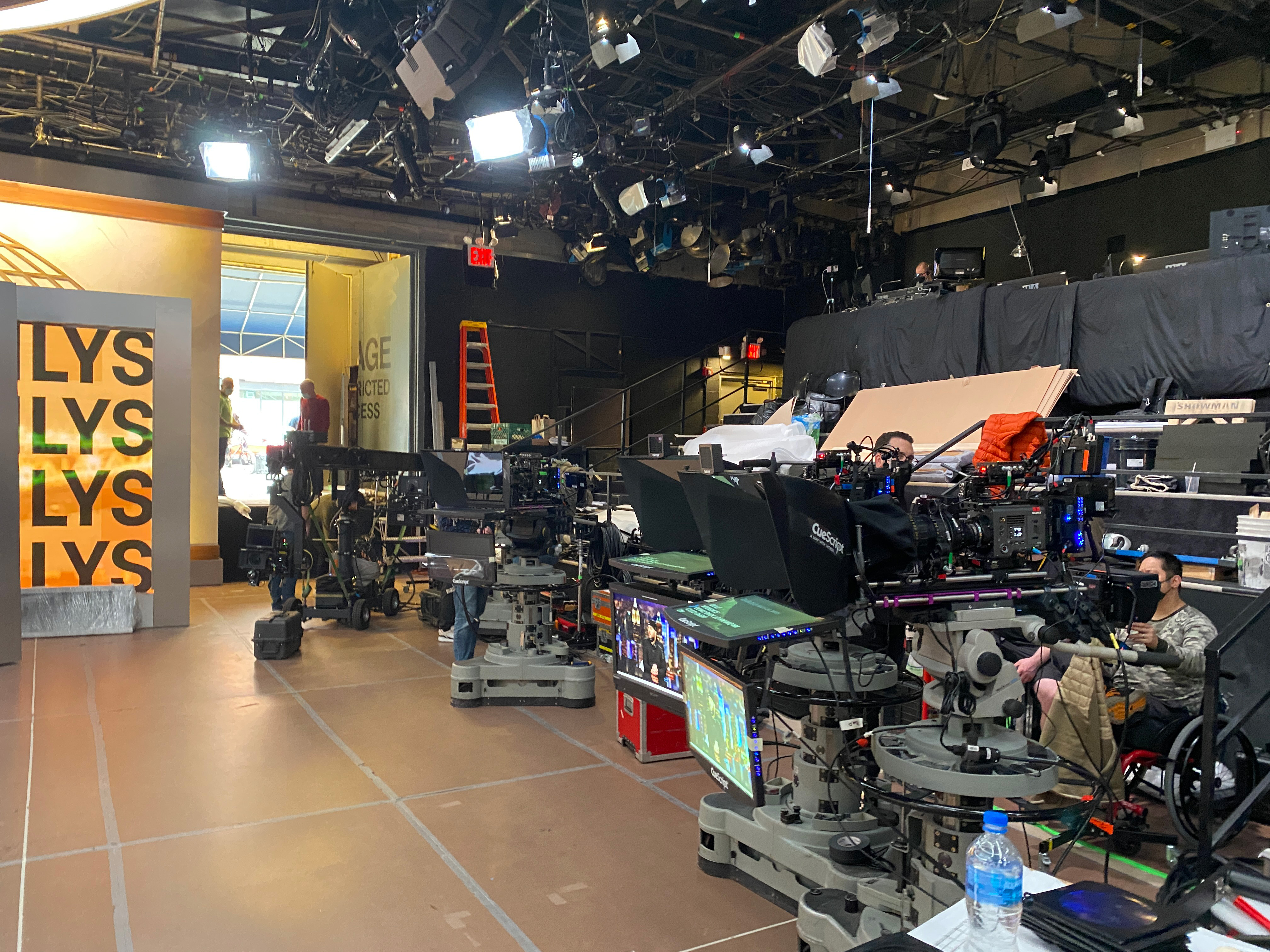Hosted by Trevor Noah since 2015, the show’s sharp, insightful humor examines the day’s biggest stories in politics, pop culture, entertainment and sports. “Everybody had to pivot and rethink a lot of it,” said Director David Paul Meyer (known as DPM on set), who has directed more than 300 episodes since 2020, having previously Segment Directed hundreds of sketches since 2015. “That’s why we shoot the way we do now. Transitioning to Noah’s home where he shot with an iPhone and no crew, then bringing the show back to a studio with no audience, and finally adding back in a live audience. This past year we had three different versions of the show. Without the whole team and the crew, it wouldn’t be possible. We really had to challenge ourselves, not just with shooting, but editing and broadcasting.”
Meyer has a long history with Noah, going as far back as his days at USC when he was working on his masters in film and television. Meyer's thesis was a documentary on standup comedy and the emerging scene in South Africa, “which really became a film about Trevor, and his career as a comedian,” he said. After the film streamed on Netflix, Noah was offered a standup comedy special and hired Meyer. When Noah secured The Daily Show, he brought Meyer with him, who began in the field department, but quickly transitioned into directing field and scripted segments. “Over the course of the pandemic, I was brought in to facilitate how to shoot from home, which led to directing the show as protocols changed and we went back to a studio.”
Meyer’s vision for the show always involved how Noah connected to his audience on screen. “I like to use the ‘I’ words with Trevor: Intimacy and Intention. During the height of the pandemic, when everybody was at home including Trevor, there was a lot of thought in terms of framing him. iPhones allowed us to do what we needed to do, but that’s where the role of intimacy came in: how big is Trevor in the frame and how are we editing the show?” When the show could return to the studio, the producers decided they needed a reset, and took the show to a new venue in Times Square, still without an audience. “We questioned what we were going to take from Trevor’s house, in addition to what we wanted from the show pre-pandemic,” said Meyer. “We were going to be in a new studio, but Trevor still wanted the intimacy with the camera. The question was, with broadcast cameras, how can we make it feel more intimate?”
Tech Supervisor Eric Zeller and Tech Manager Sean Kelley suggested a test demo with cameras that were not necessarily considered broadcast but could bring a cinematic quality, while still addressing the director’s vision. “When the show left the studio during the pandemic, it took on a new look, new life, new style,” said Zeller. “When the team wanted to explore options, I became involved with facilitating that. My job was to have the tools in place so the creative team could capture the show they wanted to create.” Meyer was convinced. “Since we were not a classic late-night show, I wondered how a cinematic camera would work in our world. I was really drawn to the Sony VENICE. I could see how intimacy could translate into cinematic multi-cam.” The idea that Meyer could shoot with cine lenses and have a shallower depth of field allowed him to de-emphasize the background and focus more on Noah. “The VENICE really captures Trevor’s beautiful skin. I’ve shot a lot of cameras and this is the best rendition of his skin tones,” he admitted. “Also, because we have a diverse cast of correspondents — Chieng, Desi, Dulcé, Michael, and Roy — I immediately noticed that we can utilize the color science with the camera. That was compelling.” Zeller’s next job was to integrate the cameras into the studio environment. Production rented five cameras from AbelCine, who helped assemble and customize the cameras as needed. “They were quick to respond when we needed certain parts,” said Zeller. “We had a really strong camera team with both film and studio backgrounds, and AbelCine was able to provide us with what we needed, including external servos and custom cables. It was a great effort from all partners.”

For Lighting Director George Gountas, who came on the show a year after Meyer did, it was a collaboration between himself and the DIT, Michael Maiatico, to make sure the cameras matched. “Eric had to do a lot of heavy lifting in a short time frame to get the cameras set up. It was a big undertaking,” he said. “It was clear as we transitioned that the process we learned in the film world wouldn’t necessarily work in our world, so we had to develop a hybrid. Because our graphics person is in the control room, and we have elements that roll in time with the script, we have maybe an hour or so before the show airs,” he explained.
For Zeller, there were initially some integration pieces he needed to figure out. “We had to tie it into SMPTE fiber for the signals to and from the cameras, since they weren’t integrated like a studio camera. We knew it was going to be a factor, but we addressed it right from the beginning. Once we started diving into the details, it became clear there were options and we made it work. It was a fun process and I was excited to be a part of it.”

In the broadcast world, a video shader makes sure the images match, while in a cinema setting, the DIT would set the look with the director, which is what Gountas would light for. “Here, it all has to match from the start, because we are not doing a color correction. No other show shoots on cinema cameras and goes on-air in two hours.” Gountas’ concentration wasn’t so much on the cinematic look of the cameras, but how he could support the show with lighting. Explaining his thought process, the first element of lighting is to have the look of a news show with an anchor at a desk. Secondly, it’s a late-night variety show with musicals, flashing lights, and skits. “There are elements in the grid that are designed for late night variety shows. Then I have a la carte lighting for the skits, which is where you see the VENICE shine, because we can use it to its full capacity. It’s all lit from the grid, including an eye light built into the desk for a fill light. We built in robotic moving lights that I lean on, since speed is of the essence when the writers come up with an idea. We have maximum flexibility from within the studio when lighting the show.”
With so many aspects of the show to consider on a daily basis, communication is key for Meyer. “I start the day meeting with the whole crew, and each department head talks about the big pieces of the day. Our department heads are good at staying in a constant communication loop. It’s understood that nothing is done in a vacuum, everything has a ripple effect. What happens for the show at 10 am may change at 2 pm, and we have to be nimble. Then we push a reset button on the end of the day. We are not live on the air, we are a live-to-tape environment, so it’s very much a culture.”

Gountas agreed. “DPM and I are very close, and we are both aware how important communication is to getting the show done in this time frame. I hustle out there and pre-light, and if it’s not what we use that day but he likes it, we’ll use it in a different show.” Meyer added, “George and I have a high-level visual idea of what we want the show to look like. I bring him into the conversation early and he runs with it.” The main lighting plot takes into consideration what happens every day. “We figured out the color temperature and intensity for Trevor. When we have a guest on with a different skin tone, I have a different lighting plan, but given that we are on camera and live, we are rolling key lights,” Gountas explained. “Overall, the lighting plot was designed to be very flexible. We have key lighting with individual control of each chair, and then a stand-up position on our monitor wall. We ended up on a half pearlescent filter if there is a guest who could use a little help.”
A new aspect to the show is the cutaways to greenscreen, which are live routines with Noah that are used to enhance the news stories. Noah turns to a different camera, which is focused on a greenscreen with a chromakey in the background and whatever image they use to place him in a different scenario. “I make lighting changes and adjustments based on where he is, and now we feel Trevor is in that world. It becomes a shareable clip,” said Gountas. “We experimented a lot to see where there is noise from the screen and the distance of subject to the screen. VENICE was very flexible in helping us get there,” he said. Meyer praised Gountas for knowing how to “take my ideas and run with it. So much of our relationship is in the pre-production phase, when we are rehearsing and roughing it in, and he always has the lighting plot ready.” With multiple screens in the studio, Meyer quantified that “how we light it, feeds into it. But we also utilize some shallow DOF, and focus on the color science of the cameras. You don’t want to force a form on it, so you have to find that balance and I think we come close. It’s more of a feeling that people recognize in The Daily Show. We could have used VENICE and been generic.”
Meyer also praised the camera department for their skill set, under the leadership of Technical Director Michael Williams, which included Camera Operators Matt Muro, Tim Quigley, Phil Salanto, Ricardo Sarmiento, and Rich York, who recently received their first Emmy nomination for Outstanding Technical Direction, Camerawork, Video Control for a Series, one of seven Emmy nominations for The Daily Show. “The camera team is incredibly talented, and immediately picked up on VENICE. Once I made the choice, I was handing it off to the crew, and what we do now is a testament to them,” Meyer said. “What a gift to have that experience. They were willing to be innovative and evolve, which resulted in a great combination of technician and tool.”
Meyer appreciates that the VENICE gives him a level of authenticity, especially since the show has seen so many changes. “Again, I go back to the hybrid aspect. Earlier on in Times Square, the lighting was a little too dramatic and we were too shallow. I bristle when people say it’s film style, because there is something in-between, in terms of being authentic to the genre. You don’t want to depart too far from it, or it feels too slick and awkward.”
When they returned to the studio, he used that visual language to find a more performative aspect, which played to the audience. “We still wanted intimacy, but it’s like a party and we wanted that too. With the flexibility of the VENICE, the color pops, and there is detail to Trevor I have never noticed before. Yet it also allows us to snap back into our pre-pandemic show look when it becomes an awesome broadcast camera, and you see it flex more with the lenses, and the cinematic response.” Meyer finds joy in having the audience back on set and noted that Noah has gotten more comfortable weighing in on the show. “He understands coverage. He sees how the overall vision impacts the visuals, which comes through to the crew. His name is on the show, and he wants to be an extension of that vision. Between our camera team working together as a whole, and my background, it translates into a truly distinctive look for our brand of late-night TV. I’m really proud of it. I think it stands out.” Gountas added, “We are the only show that shoots on that camera and I think people are noticing. Because of the VENICE, the look of our show is unique to late-night shows.”
















AbelCine encourages comments on our blog posts, as long as they are relevant and respectful in tone. To further professional dialog, we strongly encourage the use of real names. We reserve the right to remove any comments that violate our comment policy.
AbelCine publishes this blog as a free educational resource, and anyone may read the discussions posted here. However, if you want to join the conversation, please log in or register on our site.
We use Disqus to manage comments on this blog. If you already have a Disqus account registered under the same email as your AbelCine account, you will automatically be logged in when you sign in to our site. If not, please create a free account with Disqus using the same email as your AbelCine account.